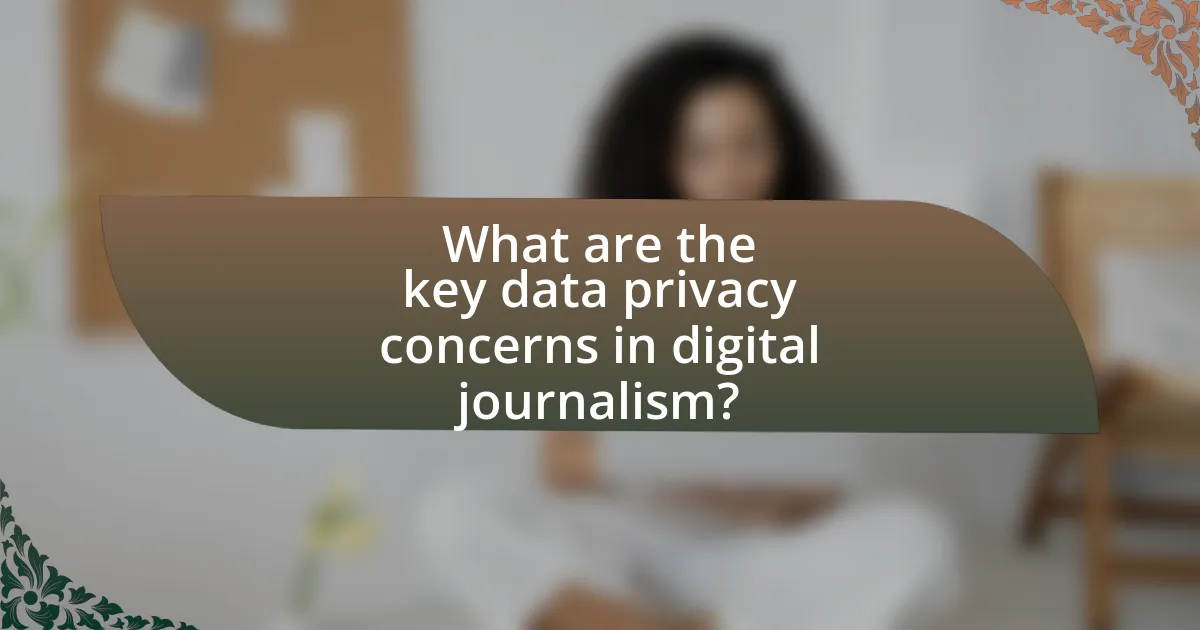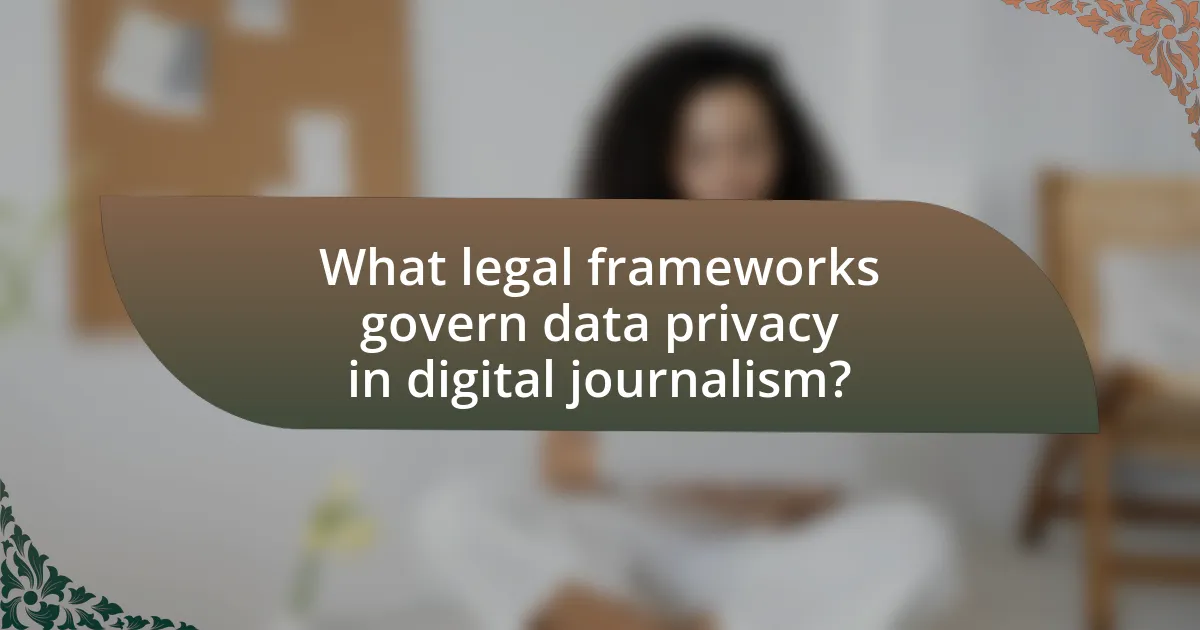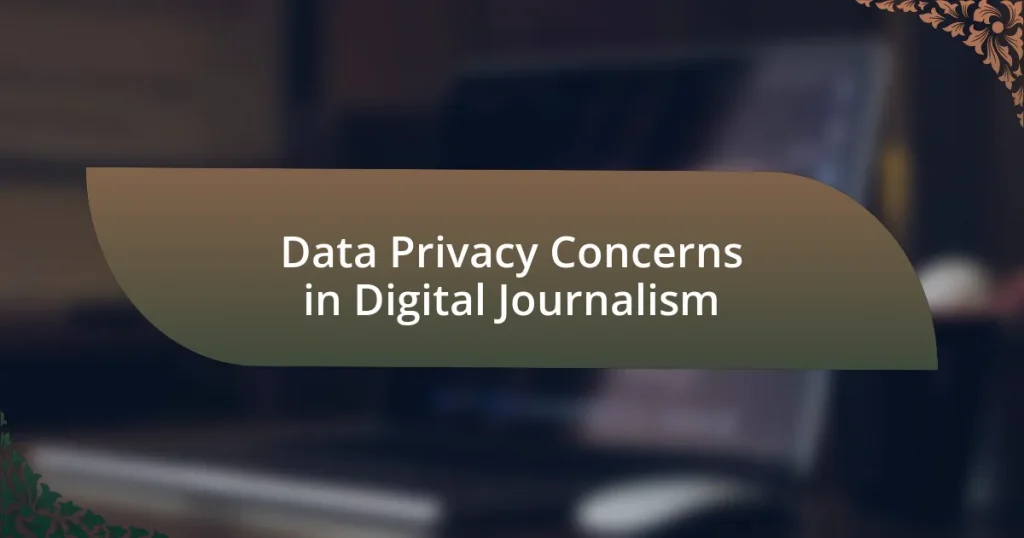The article focuses on data privacy concerns in digital journalism, highlighting issues such as unauthorized data collection, user tracking, and data breaches. It examines the impact of these privacy issues on journalists’ ability to protect sources and conduct investigative reporting, as well as the implications for audience trust and engagement. Key vulnerabilities include personal information of sources and sensitive editorial communications, while legal frameworks like the GDPR and CCPA shape journalistic practices. The article also outlines best practices for journalists to safeguard data privacy and discusses the importance of transparency and training in fostering a culture of data protection within news organizations.

What are the key data privacy concerns in digital journalism?
Key data privacy concerns in digital journalism include unauthorized data collection, user tracking, and the potential for data breaches. Unauthorized data collection occurs when journalists gather personal information without consent, violating privacy rights. User tracking involves monitoring online behavior, which can lead to profiling and targeted advertising without user awareness. Data breaches pose significant risks, as sensitive information can be exposed, leading to identity theft or harassment. According to a 2021 report by the Pew Research Center, 81% of Americans feel they have little to no control over the data collected about them, highlighting widespread concern over privacy in the digital landscape.
How do data privacy issues impact journalists and their work?
Data privacy issues significantly impact journalists by limiting their ability to protect sources and gather information securely. Journalists often rely on confidential sources to expose wrongdoing, but data privacy breaches can lead to the exposure of these sources, discouraging whistleblowers from coming forward. For instance, the 2013 revelations by Edward Snowden highlighted how government surveillance could compromise journalistic integrity and source confidentiality. Additionally, data privacy concerns can hinder investigative reporting, as journalists may face legal repercussions or harassment for accessing sensitive information. The chilling effect of potential data breaches can ultimately stifle free expression and the public’s right to know.
What types of data are most vulnerable in digital journalism?
The types of data most vulnerable in digital journalism include personal information of sources, unpublished materials, and sensitive editorial communications. Personal information, such as names, contact details, and background data of sources, can be exploited if exposed, leading to potential harm or intimidation. Unpublished materials, including drafts and notes, are at risk of unauthorized access, which can compromise journalistic integrity and the confidentiality of sources. Sensitive editorial communications, such as internal discussions and strategy documents, are also vulnerable, as breaches can undermine trust and affect the publication’s credibility. These vulnerabilities are exacerbated by the increasing use of digital platforms and the prevalence of cyberattacks targeting news organizations.
How can data breaches affect journalistic integrity?
Data breaches can severely undermine journalistic integrity by compromising the confidentiality of sources and sensitive information. When journalists’ data is exposed, it can lead to the identification of whistleblowers or confidential informants, which jeopardizes their safety and willingness to share information. For instance, the 2013 data breach of the Associated Press resulted in the exposure of journalists’ communications, leading to a loss of trust among sources and a chilling effect on investigative reporting. This erosion of trust can diminish the quality and depth of journalism, as sources may become reluctant to provide information, fearing exposure or retaliation.
Why is data privacy important for audience trust in journalism?
Data privacy is crucial for audience trust in journalism because it ensures that personal information is protected, fostering a safe environment for readers to engage with content. When journalists uphold data privacy, they demonstrate respect for their audience’s autonomy and confidentiality, which enhances credibility. Research indicates that 81% of consumers feel a lack of control over their personal information, leading to skepticism towards media outlets that do not prioritize privacy. This skepticism can diminish audience loyalty and engagement, as trust is foundational in the relationship between journalists and their audience.
How does audience perception of privacy influence their engagement?
Audience perception of privacy significantly influences their engagement with digital journalism. When audiences feel that their privacy is respected and protected, they are more likely to engage with content, share information, and participate in discussions. Conversely, if they perceive a threat to their privacy, such as data breaches or intrusive tracking, their engagement levels tend to decrease. A study by the Pew Research Center found that 81% of Americans feel they have little to no control over the data collected about them, which correlates with decreased trust and engagement in online platforms. This indicates that privacy perceptions directly impact user behavior and interaction with digital journalism.
What role does transparency play in maintaining audience trust?
Transparency is crucial in maintaining audience trust, as it fosters open communication and accountability. When digital journalism organizations disclose their data collection practices, editorial processes, and potential conflicts of interest, they empower audiences to make informed decisions about the information they consume. Research indicates that 81% of consumers feel a stronger connection to brands that are transparent about their data usage (Edelman Trust Barometer, 2021). This connection enhances trust, as audiences perceive transparency as a commitment to ethical standards and respect for their privacy. Thus, transparency not only builds trust but also reinforces the credibility of digital journalism in an era marked by data privacy concerns.

What legal frameworks govern data privacy in digital journalism?
The legal frameworks governing data privacy in digital journalism include the General Data Protection Regulation (GDPR) in the European Union, the California Consumer Privacy Act (CCPA) in the United States, and various national laws that address data protection and privacy. The GDPR, effective since May 2018, establishes strict guidelines for data collection, processing, and storage, requiring consent from individuals for their data to be used. The CCPA, enacted in 2018, grants California residents specific rights regarding their personal information, including the right to know what data is collected and the right to delete it. Additionally, many countries have their own data protection laws that align with international standards, further influencing how digital journalism practices data privacy.
How do laws like GDPR affect journalistic practices?
Laws like GDPR significantly impact journalistic practices by imposing strict regulations on data collection and processing. Journalists must ensure compliance with consent requirements, which can limit their ability to gather information from sources without explicit permission. For instance, GDPR mandates that individuals have the right to access their data and request its deletion, which can hinder investigative reporting if sources withdraw consent. Additionally, the potential for hefty fines for non-compliance, which can reach up to 4% of annual global turnover, creates a cautious environment where journalists may avoid certain data-driven stories to mitigate legal risks. This regulatory framework thus necessitates a careful balance between the public’s right to know and individuals’ privacy rights, fundamentally altering how journalists approach their work in the digital age.
What are the key provisions of GDPR relevant to journalists?
The key provisions of GDPR relevant to journalists include the principles of data processing, the right to access, the right to rectification, and the right to erasure. GDPR mandates that personal data must be processed lawfully, transparently, and for specific purposes, which impacts how journalists collect and use information. Journalists have the right to access personal data held about them and can request corrections to inaccurate data. Additionally, individuals can request the deletion of their data under certain conditions, which journalists must consider when reporting. These provisions ensure that while journalists can pursue their work, they must also respect individuals’ privacy rights as outlined in GDPR.
How can journalists ensure compliance with data protection laws?
Journalists can ensure compliance with data protection laws by implementing strict data handling protocols and obtaining informed consent from individuals before collecting or using their personal information. Adhering to regulations such as the General Data Protection Regulation (GDPR) in Europe, which mandates transparency and accountability in data processing, is essential. Additionally, journalists should regularly undergo training on data protection laws and best practices to stay updated on legal requirements and ethical standards. This approach not only safeguards individuals’ privacy but also enhances the credibility and trustworthiness of journalistic practices.
What are the implications of data privacy regulations on news organizations?
Data privacy regulations significantly impact news organizations by imposing stricter guidelines on how they collect, store, and use personal data. These regulations, such as the General Data Protection Regulation (GDPR) in Europe, require news organizations to obtain explicit consent from users before processing their data, which can limit their ability to personalize content and target advertisements effectively. Additionally, non-compliance with these regulations can result in substantial fines; for instance, GDPR violations can lead to penalties of up to 4% of a company’s global revenue. Consequently, news organizations must invest in compliance measures, which can divert resources from journalism and reporting activities.
How do regulations shape the way news is collected and reported?
Regulations significantly influence how news is collected and reported by establishing legal frameworks that govern journalistic practices. These regulations, such as data protection laws like the General Data Protection Regulation (GDPR) in Europe, mandate that news organizations obtain consent before collecting personal data, thereby shaping their data collection methods. For instance, GDPR requires journalists to ensure transparency and accountability in their data handling, which can limit the types of information they can gather and how they report on sensitive topics. Additionally, regulations can impose penalties for non-compliance, compelling news organizations to adopt stricter protocols for data privacy, ultimately affecting the scope and nature of their reporting.
What challenges do news organizations face in adhering to these regulations?
News organizations face significant challenges in adhering to data privacy regulations, primarily due to the complexity and variability of these laws across different jurisdictions. Compliance requires extensive resources for legal expertise and technology to ensure data protection, which can strain smaller organizations. Additionally, the rapid pace of technological advancement often outpaces regulatory frameworks, leading to uncertainty about compliance requirements. For instance, the General Data Protection Regulation (GDPR) in Europe imposes strict guidelines on data handling, and failure to comply can result in hefty fines, which further complicates adherence for news organizations.

What best practices can journalists adopt to protect data privacy?
Journalists can adopt several best practices to protect data privacy, including using encryption for communications, employing secure passwords, and utilizing privacy-focused tools. Encryption ensures that sensitive information remains confidential during transmission, while strong passwords prevent unauthorized access to accounts. Additionally, tools like virtual private networks (VPNs) and secure file-sharing services help safeguard data from potential breaches. According to the 2021 Digital Security Survey by the International Federation of Journalists, 70% of journalists reported using encryption to protect their communications, highlighting its importance in maintaining data privacy.
How can journalists safeguard their sources and sensitive information?
Journalists can safeguard their sources and sensitive information by employing encryption tools, secure communication channels, and anonymity practices. Utilizing end-to-end encryption for emails and messaging apps, such as Signal or WhatsApp, ensures that conversations remain confidential and inaccessible to unauthorized parties. Additionally, journalists should avoid using personal devices for work-related communications to minimize the risk of data breaches. Implementing secure storage solutions for sensitive documents, like encrypted cloud services, further protects information from unauthorized access. According to a 2021 report by the Committee to Protect Journalists, over 40% of journalists have faced threats to their sources, highlighting the critical need for robust security measures in the field.
What tools and technologies are available for data protection?
Data protection tools and technologies include encryption software, firewalls, data loss prevention (DLP) solutions, and secure access controls. Encryption software, such as AES (Advanced Encryption Standard), protects data by converting it into a secure format that can only be read with a decryption key. Firewalls act as barriers between trusted internal networks and untrusted external networks, preventing unauthorized access. Data loss prevention solutions monitor and control data transfers to prevent sensitive information from being leaked. Secure access controls, including multi-factor authentication, ensure that only authorized users can access sensitive data. These technologies are essential for safeguarding personal and organizational data against breaches and unauthorized access.
How can journalists educate themselves about data privacy risks?
Journalists can educate themselves about data privacy risks by engaging in specialized training programs, attending workshops, and utilizing online resources focused on data protection. For instance, organizations like the International Journalists’ Network offer courses that cover the fundamentals of data privacy and security. Additionally, reading authoritative publications such as the General Data Protection Regulation (GDPR) guidelines and resources from the Electronic Frontier Foundation can provide critical insights into legal frameworks and best practices. Furthermore, participating in webinars and conferences dedicated to digital journalism and data ethics can enhance their understanding of current threats and mitigation strategies.
What strategies can news organizations implement to enhance data privacy?
News organizations can enhance data privacy by implementing robust encryption protocols for data storage and transmission. This strategy protects sensitive information from unauthorized access, as encryption transforms data into a format that is unreadable without the correct decryption key. Additionally, organizations should adopt strict data minimization practices, collecting only the necessary information from users, which reduces the risk of exposure in case of a data breach. Regular audits and compliance checks with data protection regulations, such as the General Data Protection Regulation (GDPR), further ensure that news organizations adhere to best practices in data privacy. Implementing user consent mechanisms for data collection and providing transparent privacy policies also empower users to make informed decisions about their data. These strategies collectively strengthen the overall data privacy framework within news organizations.
How can organizations create a culture of data privacy awareness?
Organizations can create a culture of data privacy awareness by implementing comprehensive training programs that educate employees about data protection laws, best practices, and the importance of safeguarding personal information. Research indicates that organizations with regular privacy training see a 50% reduction in data breaches, highlighting the effectiveness of such initiatives. Additionally, fostering an open dialogue about data privacy through workshops and discussions encourages employees to share concerns and solutions, further embedding privacy into the organizational culture.
What role does training play in improving data privacy practices?
Training plays a crucial role in improving data privacy practices by equipping individuals with the knowledge and skills necessary to handle sensitive information responsibly. Effective training programs raise awareness about data privacy laws, ethical considerations, and best practices, thereby reducing the likelihood of data breaches and misuse. For instance, organizations that implement regular data privacy training report a 50% decrease in incidents related to data mishandling, according to a study by the Ponemon Institute. This evidence underscores the importance of continuous education in fostering a culture of data protection within digital journalism and beyond.
What are the common pitfalls journalists should avoid regarding data privacy?
Journalists should avoid several common pitfalls regarding data privacy, including inadequate consent, failure to anonymize data, and neglecting to secure sensitive information. Inadequate consent occurs when journalists do not obtain explicit permission from individuals before collecting or using their data, which can lead to legal repercussions and ethical violations. Failure to anonymize data can expose individuals’ identities, especially when combining datasets, increasing the risk of privacy breaches. Neglecting to secure sensitive information, such as using unsecured networks or weak passwords, can result in unauthorized access to confidential data. These pitfalls can undermine public trust and violate privacy laws, such as the General Data Protection Regulation (GDPR), which mandates strict guidelines for data handling.
How can journalists identify and mitigate potential data risks?
Journalists can identify and mitigate potential data risks by conducting thorough risk assessments and implementing robust data protection strategies. Risk assessments involve evaluating the types of data collected, understanding the potential vulnerabilities, and recognizing the legal implications associated with data handling. For instance, journalists should familiarize themselves with data protection regulations such as the General Data Protection Regulation (GDPR), which mandates strict guidelines on data usage and consent.
To mitigate risks, journalists can employ encryption techniques to secure sensitive information, utilize secure communication channels, and regularly update their software to protect against cyber threats. Additionally, training on data privacy best practices can enhance awareness and preparedness among journalists. According to a report by the International Journal of Journalism, 70% of journalists have faced data-related challenges, highlighting the importance of proactive measures in safeguarding data integrity and privacy.
What lessons can be learned from past data privacy breaches in journalism?
Lessons learned from past data privacy breaches in journalism include the necessity for robust data protection measures, the importance of transparency with sources, and the need for comprehensive training on data security for journalists. High-profile breaches, such as the 2013 Associated Press hack, demonstrated that inadequate security protocols can lead to unauthorized access to sensitive information, compromising both journalistic integrity and source confidentiality. Furthermore, incidents like the 2017 breach of the Intercept highlighted the risks of not securing communications with whistleblowers, emphasizing the need for encrypted communication tools. These examples underscore the critical importance of implementing strong cybersecurity practices and fostering a culture of privacy awareness within news organizations.




